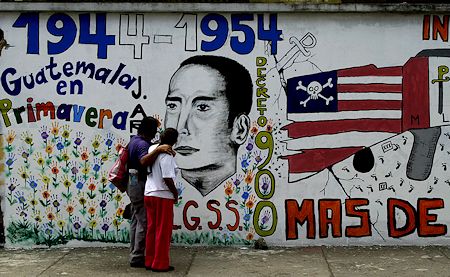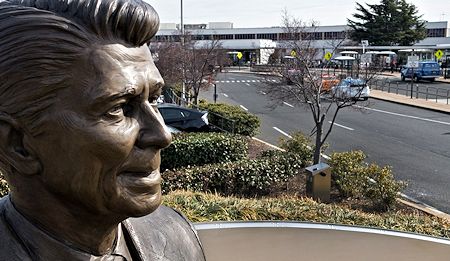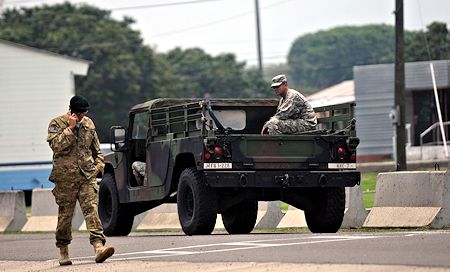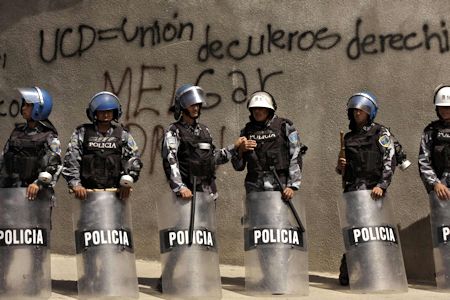|
The 57,000 children from Central America who have streamed across the
U.S.-Mexico border this year were driven in large part by the United
States itself. While Democrats and Republicans have been pointing
fingers at each other, in reality the current wave of migration from El
Salvador, Guatemala and Honduras has its roots in six decades of U.S.
policies carried out by members of both parties.
Since the 1950s,
the U.S. has sown violence and instability in Central America. Decades
of Cold War gamesmanship, together with the relentless global war on
drugs, have left a legacy of chaos and brutality in these countries. In
many parts of the region, civil society has given way to lawlessness.
It's these conditions the children are escaping.
1954: US Overthrows Arbenz
 |
| A couple walks by a graffiti mural commemorating Jacobo Arbenz in downtown Guatemala City, June 16, 2004. (AP) |
The story of the U.S.-led destabilization of
Central America began in 1954, with the overthrow of the elected
Guatemalan government of President Jacobo Arbenz. A populist leader
inspired by President Franklin Roosevelt’s “New Deal,” Arbenz had plans
for an ambitious land redistribution program that aimed to help a nation
composed largely of landless farmers.
But those plans butted against the interests of the United Fruit
Company, a U.S. corporation that owned much of Guatemala’s arable land,
along with railroad infrastructure and a port. The CIA helped engineer
the overthrow of the Arbenz government, laying the foundation for
decades of government instability and, eventually, a civil war that
would claim more than 200,000 lives by the 1980s. That war wasn't fully resolved until the 1990s.
“Our involvement in Central America has not been a very positive
one over the last 60 years,” Rep. Beto O’Rourke, a Democrat from El
Paso, Texas, told The Huffington Post. “You can go back to the coup that
overthrew Jacobo Arbenz in 1954, fully backed by the Eisenhower administration
and the Dulles brothers, who had an interest in the United Fruit
company, whose fight with the government really precipitated the crisis
that led to the coup."
It set a pattern. "You look at the decades following that, and
the military strongmen, and the juntas, and the mass killings, and it's
no wonder Guatemala is in such terrible shape today," O'Rourke said. U.S. Fuels Civil Wars
 |
| Argentinian forensic archeologist Claudia Visso works to exhume the remains of a victim of a 1991 massacre in Cerro Pando, El Salvador, Oct. 29, 2003 |
Along with the decades-long war against leftists in Guatemala, the U.S.
organized and funded El Salvador's protracted war with the FMLN, a
left-wing guerrilla movement. The U.S. also funded counterinsurgency
efforts in Honduras, which became a staging ground for the Contras.
Death squads flourished, more than 75,000 people died and civil society collapsed.
If today's crisis were simply a result of Central American
confusion about the president's policy regarding immigrant children, as
is widely alleged, one might expect children to be coming in equal
numbers from every Central American country. But notably, Nicaragua -- a
country that borders Honduras, and one in which the U.S. failed to keep
a far-left government from coming to power -- is today relatively
stable and not a source of rampant migration. It is led by President
Daniel Ortega, whose Sandinista movement took power in 1979 and held off
the U.S.-backed Contras until an opposition government was elected in
1990.
"You see the direct effects of these Cold War policies," Greg
Grandin, a professor of Latin American history at New York University,
told The Huffington Post. "Nicaragua doesn’t really have a gang problem,
and researchers have traced this back to the 1980s and U.S. Cold War
policy."
Refugees Flee Central America For The U.S.
 |
| Guatemalan women warm tortillas over an open fire inside a warehouse where the first group of 46,000 Guatemalan refugees await more permanent housing in a camp in the jungle of the state of Campeche, Mexico, July 7, 1984. (AP) |
With wars come refugees. The young people
who streamed into the United States from Central America in the late
'70s and '80s had deep experience with violence. When Alex Sanchez, the
executive director of Homies Unidos in Los Angeles, made his first
journey from El Salvador to the United States in 1979, he was only 7
years old. Like many of the 57,000 children stopped at the U.S.-Mexico
border in 2014 -- most of them from Central America -- Sanchez came to
the U.S. searching for his parents, who had immigrated to Los Angeles
five years before. When the adults he was traveling with handed him and
his 5-year-old brother to their parents in L.A., Sanchez no longer
recognized them.
“All I had was a black-and-white picture of my mother from when
she was 16,” Sanchez told The Huffington Post. “These two people were
complete strangers to us now. We didn’t know them anymore. We thought
initially that we had been sold, given to strangers -- we didn’t know
what to make of it.”
The U.S. Launches The Drug War As Cities Are Hollowed Out
 |
| A statue of former U.S. President Ronald Reagan is seen February 6, 2014 at the entrance to Ronald Reagan International Airport in Washington, D.C. (Gett |
In the mid-'80s, President Ronald Reagan and
his Democratic ally, then-Senate Judiciary Committee Chairman Joe Biden
(D-Del.), joined forces to implement draconian drug penalties,
including mandatory minimum sentences and penalties for crack that were
famously much harsher than those for powdered cocaine. The total U.S. prison population surged
from 330,000 inmates in 1980 to 1.57 million in 2012, according to the
Bureau of Justice Statistics -- making the American prison population
the largest in the world.
The Drug War And Mass Incarceration Leads To A Rise Of Gang Violence
 |
| Los Angeles police Chief William Bratton speaks at a news conference to announce an indictment naming 24 leaders, members and associates of MS-13, part of the Mara Salvatrucha gang affiliated with the Mexican Mafia prison gang, in June 2009. |
Once in the U.S., 7-year-old Alex Sanchez
had trouble adapting at school. As a Salvadoran, he was an outsider. As a
young boy recovering from the trauma of seeing decapitated bodies on
the way to school, or avoiding shortcuts across the railroad tracks
because of gunfire, he was doubly isolated from his peers. Classmates
beat him up.
One day, when a bully started giving him trouble, Sanchez fought
back. “I punched him until I started crying,” Sanchez said. “And for me
that moment was my own therapy. I just released all this anger that I
had inside on this kid.”
The next chapters in Sanchez’s life serve as a microcosm of the
United States’ dysfunctional relationship with both Central America and
its own communities of color. When Sanchez got to middle school, he
banded together with a group of Salvadorans who'd had experiences
similar to his. With strength in numbers, they protected each other. It
was the 1980s, and like other American teenagers, they listened to heavy
metal and wore their hair long. It wasn’t quite a gang -- at least not
at first -- but it evolved into one.
For Sanchez, what began as way of protecting himself as an
outsider developed into an increasing involvement in gang culture. He
was arrested and placed first in juvenile detention, then in prison. It
didn’t bother him at the time. He knew that the more time he spent in
jail, the more cred he’d have with the gang when he got out. “I actually
had a bet with one of my friends over who would go to jail first,”
Sanchez said. “I beat him by a week.”
Sanchez and his friends grew hardened by their run-ins with the law. Authorities shaved the long hair they had once favored.
“Once people started coming out from juvenile hall, they were
bringing this different culture to the neighborhood,” Sanchez said. “It
didn’t help us to be rehabilitated. It made us worse.”
Sanchez’s experience in the prison system paralleled dramatic
changes in the U.S.'s approach to law enforcement and incarceration.
"You've taken people who've been petty criminals at best and turned them
into hardened gang members by their exposure to these extremely
violent, very sophisticated criminal networks that operate out of U.S.
prisons," O'Rourke told HuffPost.
With Some Stability Restored, The U.S. Sends A Wave Of Gang Members Back To Central America
 |
| A masked 18 Street gang member stands in front of a mural after a press conference inside the San Pedro Sula prison in Honduras, Tuesday, May 28, 2013. (AP) |
After serving their sentences, many gang
members were deported back to Central America, where they quickly became
a dominant force. "They set up their own fiefdoms within these
borderline failed states," said O'Rourke, "and again, you see how you
can have the situation that we have today in Guatemala and El Salvador
and Honduras."
Rep. Karen Bass (D-Calif.) recalled growing up in Los Angeles
and watching the gang problem evolve into a deportation problem. “I do
remember us deporting many, many Salvadorans,” Bass said at a press
conference last month. “One of the things that we exported was a gang
problem that then flourished in their country, and now we’re having this
boomerang effect.”
Robert Lopez, who covers gangs for the Los Angeles Times, told
NPR that many of the deported gang members thrived in the countries of
their birth. "I've talked to veteran gang members who recall the early
days when they arrived in the early 1990s and late '80s, and they were
there with their baggy pants, their shaved heads, their gang tattoos.
And this was just such an attractive thing for Salvadoran youths," Lopez
said. "One gang member recalled inducting several hundred new members
in a matter of several days."
Sanchez was among those who returned. In the summer of 1994, he
was deported back to El Salvador -- a country he no longer knew. He
arrived with his grandfather’s address scrawled on a piece of paper.
In El Salvador, Sanchez found an environment where gang culture
was thriving. Just two years earlier, the Chapultepec Peace Accords had
ended more than a decade of civil war, but the country remained violent.
The homicide rate stood at 139 per 100,000 in 1995 -- far higher than
any country in the world today. El Salvador’s public institutions were
hobbled and its families broken up by both war and migration.
The streets were filled with homeless kids, known colloquially
as “huelepegas,” or “glue sniffers,” whom police harassed as they went
about begging for change. Like Sanchez in Los Angeles, those kids found
refuge in gangs. They especially looked up to people like Sanchez, who
had belonged to what local youths viewed as the more glamorous American
gangs they’d seen portrayed on television, Sanchez said.
“All those kids had to do was put a number on their face and go
ask for money and now people were terrified of them,” Sanchez said.
“Before, they treated them like shit. Now they were like, ‘Please don’t
hurt me.’”
The U.S.-born gangs of El Salvador like Mara Salvatrucha (MS-13)
or 18th Street are perhaps the best known, but similar street gangs
popped up throughout the so-called “Northern Triangle” countries of
Central America -- El Salvador, Honduras and Guatemala.
While deportees brought many of these gangs to Central America,
Steven Dudley, director of InSight Crime, a publication that covers
security in Latin America, said it would be wrong to conclude that
deportees created the region’s problems with violence.
“The idea of deportees in and of themselves being the cause of
the gang problem in Central America is erroneous,” Dudley told HuffPost.
“It certainly has been a contributing factor, but there is every reason
to believe that it is the conditions in which these deportees have
integrated themselves that has allowed these gangs to surge.”
The U.S. Escalates The Drug War
 |
| U.S. soldiers remain at Palmerola Air Base, near Comayagua, Honduras, on May 8, 2013. |
The vast majority of cocaine consumed in the
United States is produced in Colombia. In the 1990s, the U.S. and
Colombian governments, operating together under a security pact called
“Plan Colombia,” decimated Colombia's Cali and Medellín cartels and
broke up Caribbean transit routes. So power shifted to Mexican cartels.
In 2006, with the backing of the U.S., Mexico launched an all-out war on
its cartels. The war has left more than 70,000 dead and severely
undermined the Mexican people's faith in their government.
The violence has since drifted southward. The cartels -- some led by the same people who had belonged to U.S.-funded Central American special forces like Guatemala’s Kaibiles -- have pushed into Central America, where they've encountered gangs ready to participate in the now-lucrative trade and carry out smaller jobs.
“Today, you have an increasingly large consumer [drug] market
there that these criminal organizations are taking advantage of to grow
and become more sophisticated,” Dudley said. “The transnational cartels
are much bigger-picture. Those groups, while they might have contact
with and in some cases use the gangs for specific tasks, like
assassinating a rival, their relationship is not one that is integral or
organic ... [The local gangs] do spot or contract work.”2009: Another Coup
 |
| Riot police stand guard as supporters of ousted Honduras President Manuel Zelaya protest demanding his return to power in Tegucigalpa, Honduras, Thursday, Oct. 22, 2009. (AP) |
In 2009, the Honduran military, with the backing of the Supreme Court,
illegally overthrew the elected government of President Manuel Zelaya, a
populist reformer. In contrast to the governments of Latin America --
many of whose histories are marred by U.S.-backed coups -- the American government balked at using the term “coup” in this case, and made little effort to get Zelaya returned to power, instead pressuring Honduras' neighbors to recognize the new government.
The de facto government in Honduras used the military
to quell protests and re-establish order in the capital. Drug cartels
stepped in along the Honduras-Guatemala border, exploiting the power
vacuum, according to a report published in June by the International Crisis Group.
“Local law enforcement, always weak, fell into disarray,” the
report says. “The U.S., concerned about providing assistance to an
unaccountable and illegitimate regime, suspended non-humanitarian aid,
including counter-narcotics assistance. The result was a ‘cocaine gold
rush,’ as traffickers hurried to secure routes through the region.”
They succeeded. A 2012 State Department report
estimated that as much as 90 percent of the 700 metric tons of cocaine
shipped from Colombia to the U.S. every year passes through Central
America.
A sharp escalation of violence accompanied the 2009 coup and the
expansion of cartel operations. The Honduran homicide rate spiked from
an already high 61 per 100,000 in 2008 to 90 per 100,000 in 2012 -- the
world’s highest murder rate, according to the U.N. Office on Drugs and
Crime.
Source: U.N. Office On Drugs and Crime
Today, Honduras, El Salvador and Guatemala are horrifyingly
dangerous places. Children are fleeing. The response from much of
Congress and the tea party has been to argue for the repeal of
immigration laws so that the U.S. can quickly deport the children back
to their devastated home countries.
But that, said O'Rourke, is an abdication of responsibility.
"Just on basic humanitarian grounds we should do the right thing by
these kids and accept them as refugees -- or the legal term is 'asylum
seekers' -- but we also own this problem, we have culpability in it,
whether it's our involvement with thuggish governments there in the
past, or whether it's the fact we are the world's largest consumer of
illegal drugs that are transited through these countries, or whether
it's the war on drugs that we've foisted upon these countries," he said.
"All of those things contribute to the destabilization, the insecurity,
the failed governance, the lack of civil society development. So, one,
we should help now that we've done so much to create this situation and,
two, we should work constructively with regional partners to rebuild these societies to the best that we can."
Source: Huffington Post
|

